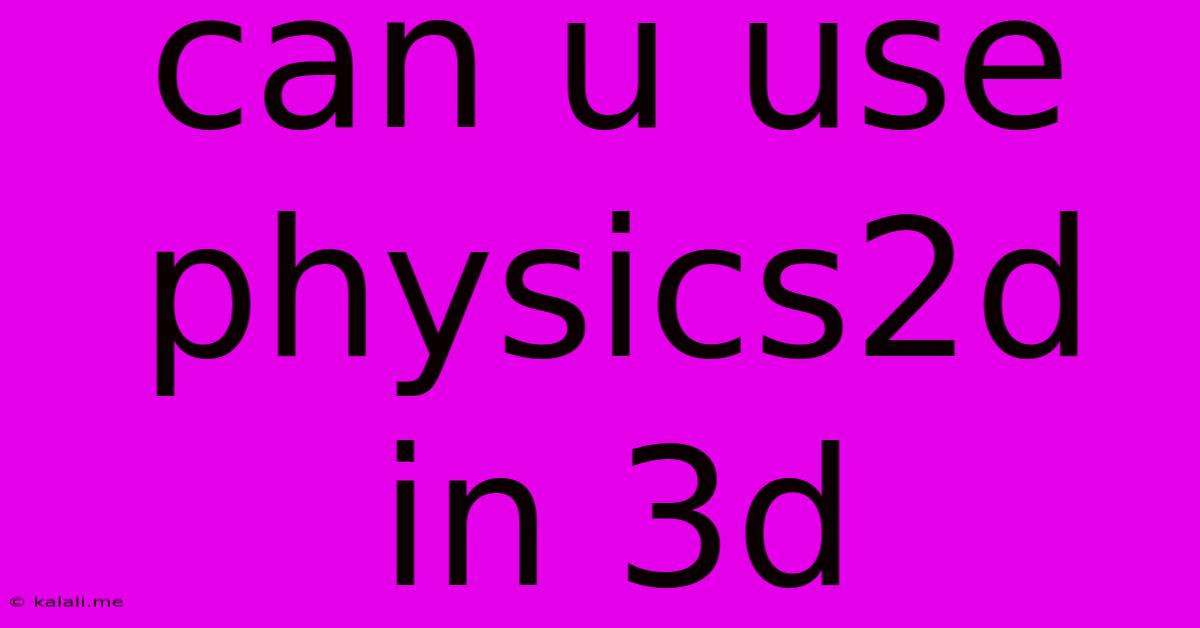Can U Use Physics2d In 3d
Kalali
May 23, 2025 · 3 min read

Table of Contents
Can You Use Physics2D in 3D? Understanding the Limitations and Workarounds
Physics engines are crucial for realistic simulations in game development and other applications. While Physics2D is designed for 2D environments, many developers wonder if it's possible to leverage its capabilities in a 3D context. The short answer is: not directly, but there are creative workarounds to achieve similar results. This article will delve into the reasons behind this limitation and explore the alternative approaches available.
This article will explain why directly using Physics2D in a 3D environment isn't feasible, detail the challenges involved, and outline various strategies for simulating 2D physics in a 3D world. We'll cover common use cases and offer practical advice for developers looking to implement these techniques.
Why Physics2D Doesn't Work in 3D
Physics2D is specifically optimized for two-dimensional space. Its algorithms are designed to handle collisions, forces, and other physical interactions within a plane. Extending this to three dimensions requires significant modifications because:
- Computational Complexity: 3D physics simulations are significantly more computationally expensive than their 2D counterparts. The increased number of dimensions dramatically increases the number of calculations needed for collision detection and resolution. Physics2D lacks the architecture to handle this increased complexity efficiently.
- Collision Detection: 2D collision detection is relatively straightforward. In 3D, accurate and efficient collision detection becomes much more challenging, requiring more sophisticated algorithms and data structures that are not present in Physics2D.
- Rigid Body Dynamics: Physics2D's rigid body dynamics are designed for 2D rotations and translations. Introducing a third rotational axis in 3D necessitates a completely different approach to simulating rigid body motion.
Workarounds for Simulating 2D Physics in 3D
Despite the direct limitations, you can effectively mimic 2D physics behaviors within a 3D environment using several techniques:
-
Constraining Movement: This is the simplest approach. You can essentially force your 3D objects to move only along two axes (e.g., X and Z) while ignoring the Y-axis. This is suitable for scenarios where the 2D physics are primarily concerned with horizontal movement. You would manually constrain the position and rotation of the objects.
-
Using a 3D Physics Engine with 2D Constraints: Modern 3D physics engines like Unity's Physics engine or Box2D (which, despite its name, can be used in 3D with limitations) allow you to define constraints that restrict movement to two dimensions. By using these constraints, you can create the illusion of 2D physics within a 3D environment. This offers more precision and handles collisions more robustly than simple manual constraints.
-
Layer-Based Approach: This involves creating a separate 2D layer in your 3D scene. Objects residing within this layer will only interact according to 2D physics rules. This might require custom scripting to manage interactions between the 2D and 3D layers.
Choosing the Right Approach
The best approach depends on the specific requirements of your project. For simple scenarios with minimal interaction, constraining movement directly might suffice. For more complex simulations requiring accurate collision detection and interactions, using a 3D physics engine with 2D constraints is the recommended approach. The layered approach offers flexibility for larger projects, but introduces complexity.
Remember to carefully consider performance implications. 3D physics engines are generally more resource-intensive than their 2D counterparts. Optimizing your code and leveraging efficient algorithms is crucial for maintaining a smooth frame rate, especially in complex 3D environments.
In conclusion, while you cannot directly use Physics2D in a 3D environment, several creative methods allow you to achieve similar results. By carefully choosing the appropriate technique and considering performance optimization, developers can successfully incorporate 2D-like physics into their 3D projects.
Latest Posts
Latest Posts
-
How Many Days Is 72 Hours From Tuesday
Jun 30, 2025
-
How Many Cups Are In 3 Quarts Of Water
Jun 30, 2025
-
25 Cents A Minute For An Hour
Jun 30, 2025
-
In Music What Does Allegro Mean Math Answer Key Pdf
Jun 30, 2025
-
What Is 1 5 Of A Tablespoon
Jun 30, 2025
Related Post
Thank you for visiting our website which covers about Can U Use Physics2d In 3d . We hope the information provided has been useful to you. Feel free to contact us if you have any questions or need further assistance. See you next time and don't miss to bookmark.